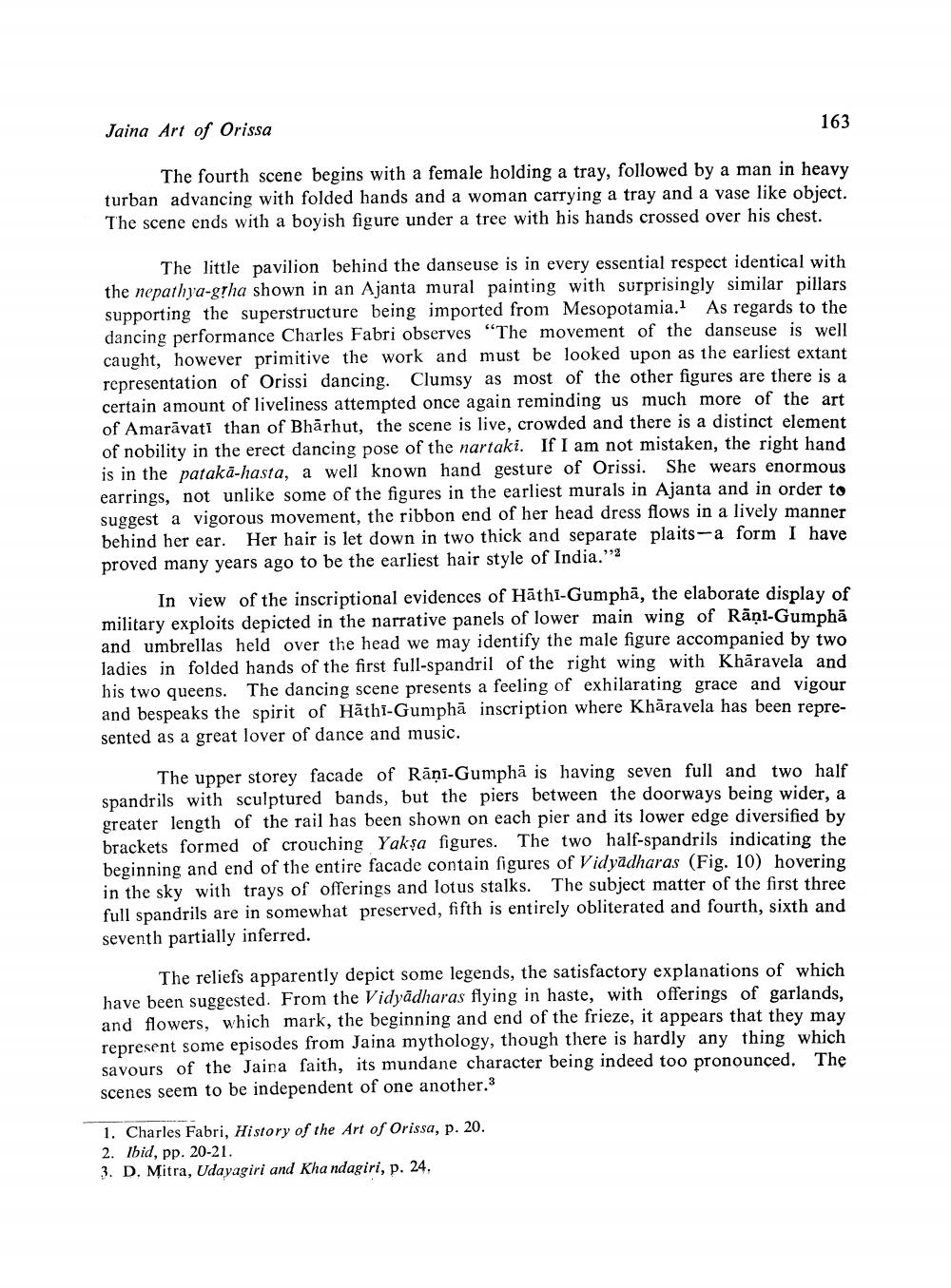________________
Jaina Art of Orissa
163
The fourth scene begins with a female holding a tray, followed by a man in heavy turban advancing with folded hands and a woman carrying a tray and a vase like object. The scene ends with a boyish figure under a tree with his hands crossed over his chest.
The little pavilion behind the danseuse is in every essential respect identical with the nepathya-grha shown in an Ajanta mural painting with surprisingly similar pillars supporting the superstructure being imported from Mesopotamia. As regards to the dancing performance Charles Fabri observes "The movement of the danseuse is well caught, however primitive the work and must be looked upon as the earliest extant representation of Orissi dancing. Clumsy as most of the other figures are there is a certain amount of liveliness attempted once again reminding us much more of the art of Amarāvati than of Bhārhut, the scene is live, crowded and there is a distinct element of nobility in the erect dancing pose of the nartaki. If I am not mistaken, the right hand is in the patakā-hasta, a well known hand gesture of Orissi. She wears enormous earrings, not unlike some of the figures in the earliest murals in Ajanta and in order to suggest a vigorous movement, the ribbon end of her head dress flows in a lively manner behind her ear. Her hair is let down in two thick and separate plaits-a form I have proved many years ago to be the earliest hair style of India.''
In view of the inscriptional evidences of Hāthi-Gumphā, the elaborate display of military exploits depicted in the narrative panels of lower main wing of Rāņi-Gumpha and umbrellas held over the head we may identify the male figure accompanied by two ladies in folded hands of the first full-spandril of the right wing with Khāravela and his two queens. The dancing scene presents a feeling of exhilarating grace and vigour and bespeaks the spirit of Hāthi-Gumphā inscription where Khāravela has been represented as a great lover of dance and music.
The upper storey facade of Rāņi-Gumphā is having seven full and two half spandrils with sculptured bands, but the piers between the doorways being wider, a greater length of the rail has been shown on each pier and its lower edge diversified by brackets formed of crouching Yakşa figures. The two half-spandrils indicating the beginning and end of the entire facade contain figures of Vidyadharas (Fig. 10) hovering in the sky with trays of offerings and lotus stalks. The subject matter of the first three full spandrils are in somewhat preserved, fifth is entirely obliterated and fourth, sixth and seventh partially inferred.
The reliefs apparently depict some legends, the satisfactory explanations of which have been suggested. From the Vidyādharas flying in haste, with offerings of garlands, and flowers, which mark, the beginning and end of the frieze, it appears that they may represent some episodes from Jaina mythology, though there is hardly any thing which savours of the Jaina faith, its mundane character being indeed too pronounced. The scenes seem to be independent of one another.3
1. Charles Fabri, History of the Art of Orissa, p. 20. 2. Ibid, pp. 20-21. 3. D. Mitra, Udayagiri and Kha ndagiri, p. 24.




